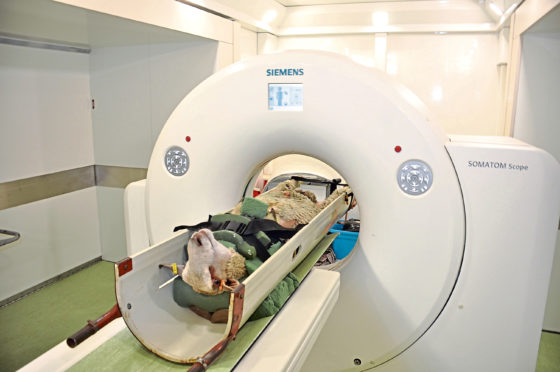Sheep farmers are being challenged to breed for extra chops by making more use of the information provided by the CT scanning of live lambs.
According to researchers at Scotland’s Rural College (SRUC), who have been using CT (computer tomography) technology for more than two decades, the process enables farmers see the total fat and muscle in live animals, with the ultimate goal of being able to improve lean meat yield.
“These scans, together with growth and ultrasound images taken on farms, allow pedigree breeders to identify the best animals in a flock for breeding,” said SRUC.
“Following research, analysing spine length and the number of vertebrae across and within different breeds of sheep, scientists have found that, for minimal extra expense, producers could increase the size of high-priced loin cuts, alongside selection for breeding goals such as growth, total carcass fat and muscle.
“These new measurements have been added to a national sheep breeding programme provided by Signet Breeding Services.”
Nicola Lambe, sheep geneticist at SRUC and manager of the CT unit, added: “Selection for increased numbers of vertebrae or spine length in the thoracic and/or lumbar regions would produce more, or thicker, ribs or chops.”
CT scans, which cause no harm to the animals or meat, are also being used to measure the amount of marbling or flecks of fat within the muscles, factors which contribute to the juiciness and flavour of the meat.
SRUC said: “This second trait predicting the intramuscular fat percentage (IMF%) has also been added to the national breeding programme, together with another measurement looking at the eye muscle area – the area across the loin – which provides a reliable indicator of how much meat will be yielded in a sheep’s carcass.”
In addition, researchers are now using images taken from nearly 20,000 sheep scanned over the past 20 years to look at other issues, including studying the link between pelvic dimensions and lambing difficulties.
They have also started scanning the neck of Texel sheep, as part of preliminary studies to investigate links between the shape of the larynx and laryngeal chondritis – a respiratory tract disease that affects this breed.
Ms Lambe said: “Information taken from the scans is fed into the national breeding programme, adding accuracy to breeding values, especially for CT-scanned lambs, but also for all other related lambs in the programme.”
